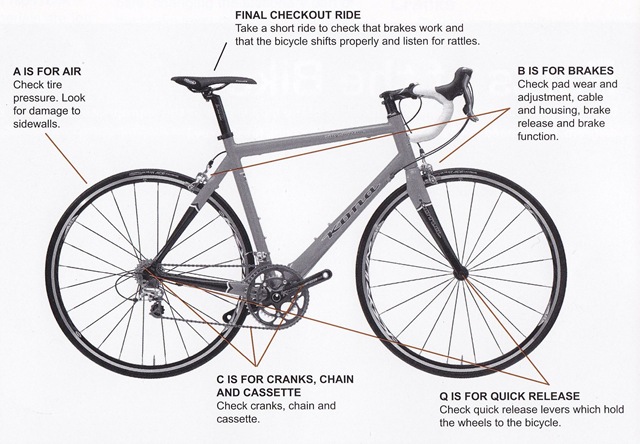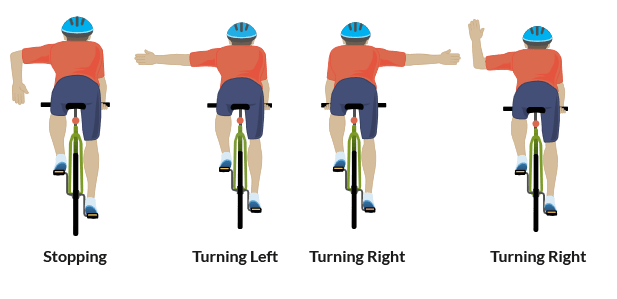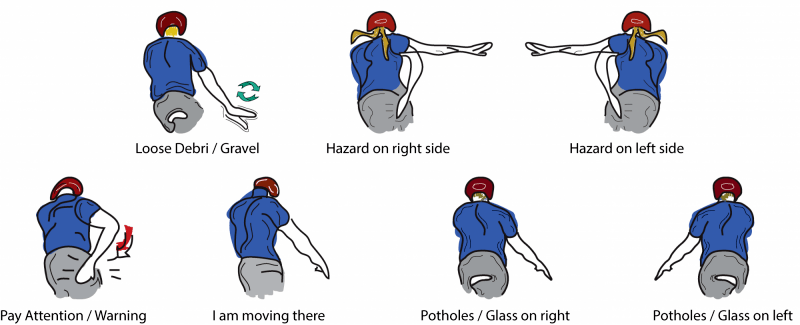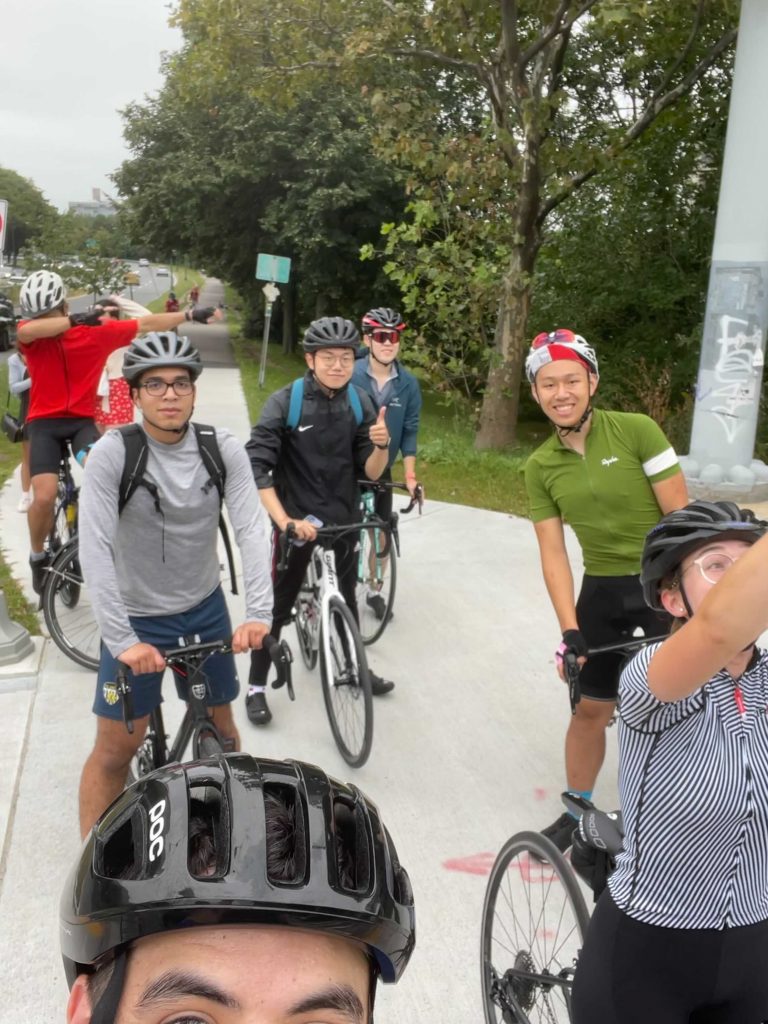Group rides are a wonderful way to get to know other people who love bikes, explore a new town or part of the city, and to get outside. With that said, here are some things we want everyone at BU Club Cycling to know before their first ride. While by no means an extensive guide, this should be enough to get most people started. Please reach out to the E-board (or comment on this post) if you have any questions!
Gear
Required:
There are very few absolute must-haves for group rides. Among them:
A safe, working bike. This should go without saying, but if you have recently crashed your bike, don't take it on a ride before getting it checked at a bike shop. Besides that check the following: make sure your brakes (you should have both front and rear - sorry fixies) work and the pads or discs are not too worn. If you need to repair your brakes or replace pads or discs, please refer to Landry’s for service. You should also ensure that there is air in your tires, either with a full tube or well-placed sealant for those running tubeless. If you need air, several current members have pumps with them and there is also a pump station compatible with both Presta and Schrader valves in GSU Plaza. Last check: make sure you can shift smoothly into all the gears and cogs on your bike. Refer to this ABC Quick Check and the image below before you leave for a ride to make sure everything is working properly.

A helmet that fits well and will protect your head. We will absolutely not accept anyone not wearing a helmet on our rides, no exceptions. Make sure your helmet properly fits your head: you should be able to open your mouth wide comfortably, without the chin strap digging into your neck, but it should also not be loose enough that the helmet shifts when you shake your head side to side or up and down. If you have a knob on the back that can adjust the tightness of the helmet fit, make it comfortably secure. Your helmet should not cause headaches but also should not move from your head. Helmet straps should be clipped at all times during the ride, but you’re of course free to take it off if we stop for snacks or coffee. Finally, look on the inside of your helmet for a sticker certifying that it meets safety standards. If your helmet is very old, it’s likely that the standards and the technology have evolved, so consider replacing it with a newer one. You can get a free helmet from the BU Parking and Transportation Services office during working hours.
Here’s a quick helmet fit check to do before your first ride with us:

Navigation. However you do this (phone with Google Maps or RideWithGPS, turn-by-turn directions printed out and taped to your bars, or a mounted bike computer), you need to be able to get around on your own if you get separated from the group. We will absolutely do our best to keep track of everyone, but if we split up and someone takes a wrong turn, you don’t wanna be lost in the middle of nowhere without a cell signal. We will have ride leaders with their own GPS/phone setup, so you don’t need to have your devices turned on at all times, but do keep them handy just in case. You should also install Uber or Lyft in case you need to catch a ride home, and keep a little bit of cash on you to tip the driv
Phone and ID. If you do get separated from the group, call your ride leader/the acting President. If they can, they will come get you and reunite you with the group at the next stopping point. In the very worst case, you will at least have a way to call a ride home, and you’ll want to have your ID (and a health insurance card, if applicable) on you at all times anyway.
Mask. You don’t need to wear one on the ride, but if we stop for a bathroom break or at a cafe or gas station, you will need one. Masks are still required indoors in Boston, as well as in many other towns of Massachusetts. Whatever mask you wear to class should be perfectly fine.
Highly Recommended:
Water and snacks. You won’t get far if you don’t fuel! Recommended intake for best performance is 2 small bottles / hour and about 200-400 calories’ worth of carbohydrate, either in the form of drink mix, gels, or solid food. Of course, this varies with length and intensity, but you should at the very least bring one full bottle of water and a small snack with you. Most of our group rides will also include a cafe stop for bathroom breaks, real food, bottle refills, and that sweet sweet caffeine.
Daylight-running lights. Our group rides will be during the day, which means lights are not required but still highly recommended. A bright set of lights gets other road users’ attention sooner and allows more time for safe passing. This is especially important on roads we share with motor vehicles, as well as on shared-use cycle- and footpaths. If you’re riding before dawn or after dusk, you absolutely must have lights on your bike. Reflectors only shine when light hits them, whereas lights do so on their own, in the absence of other light sources. Staying visible with bright lights is one of the best ways to avoid a crash or scary interaction with other road users.
A flat repair kit. Flats happen: it’s the nature of riding on variable surfaces, especially in pothole-heavy areas. Nothing derails a ride quite like a flat, but if you come prepared you won’t have to Uber home. A flat repair kit typically includes: a pair of tire levers, patches and rubber cement, a pump or CO2 canisters, sealant and/or at least one spare tube.
A multi-tool. Besides flats, you may encounter other mechanicals that could easily be resolved with a roadside repair. For that, we highly recommend a bike-specific multitool with several modalities, including hex wrenches, a chain breaker, and flat- and phillips-head screwdrivers. The good folks at Landry’s can help get you set up for success in this area!
Pockets or a bag. You’ll need somewhere to store all this stuff! Cycling jerseys, vests, and jackets usually come with at least 3 roomy pockets, but cargo shorts, saddlebags, bar bags, and frame bags also work.
Padded cycling shorts. Having fun on a ride is why we all do it, so you don’t have to resign yourself to saddle discomfort. Padded cycling shorts or bibs worn on the skin (no underwear) can really help if you feel like you’re at a loss. Unlike a padded saddle, the shorts or bibs will move with your body and wick away sweat. Again, Landry’s is a great place to find a good fit for shorts, but you can also visit TheBlackBibs for a budget option. Be prepared to try more than one pair, since padding, body shape, and specific problem areas are so individual. And if you want a pair of team-branded bibs, contact the E-board or keep an eye out for the next kit order!
Clipless pedals and matching cleats. Flat pedals are perfectly fine (the legs, not the gear, make the rider), but if you really want to take advantage of all that force you’re producing, clipless pedals are where it’s at. They allow you to pull up on the upstroke of the pedal as well as push down on the downstroke, effectively doubling the energy transfer between your legs and your bike. If you’re considering racing, we highly recommend practicing using clipless pedals earlier rather than later, since there is quite a learning curve involved to having your legs essentially strapped to your bike. However, for your safety as well as that of others, we don’t recommend trying clipless pedals for the first time on your first group ride, so don’t sweat it if you don’t have them yet (or don’t ever want to!). For now, just hop on and ride whatever you got!
Road Safety
This section is meant to prepare you, not to overwhelm or scare. If you have concerns, please talk to a member of the E-board before your first ride. Don't feel compelled to attend every group ride if you're not ready yet - we have workshops planned that will help you practice the necessary skills in a controlled and safe environment. Also remember: the vast majority of rides go wonderfully, but it's always the one or two bad run-ins that everyone remembers.
Communication: Signalling with Your Hands and Voice
Here are the 4 main hand signals you should know, and which we will use on all our rides:

You should use these signals as often as is safely possible to communicate with the riders around you, drivers, pedestrians, and other road users. If you’re not comfortable yet with taking one hand off the bars to signal, don’t sweat it for now: we will have a series of workshops that will help you to practice these skills. Instead, use your voice: the ride leaders will often call out “slowing!”, “stopping!”, “go left!”, or “go right!” in addition to using hand signals to communicate with everyone else. Help us out by lending your voice, too!
In addition, we will also be calling out holes, debris, and other obstacles in the road with both our voices and other hand signals:

Finally, in cases where we need to call out other road users (for example, at intersections), you may hear:
- “Car right!” or “Car left!” to indicate a car to the group’s right or left at an intersection: a warning both for us to stay alert for the driver turning into us, but also for the driver to acknowledge that we’ve seen them.
- “Clear!” to indicate that the intersection is clear, and we are safe to roll through or turn.
- “Car back!” to indicate a car passing the group from the back; if safe and possible, move over to the right to give them room. If it is not safe for the driver to pass, a ride leader will signal to them and communicate with the group.
- “Walker/runner up!” “Dog up!” “Kids up!” to indicate, on a shared-use path, that pedestrians, pets, and children are also using the path. In these cases we will slow down or stop until it is safe to pass.
- “On your left!” to indicate that a rider is passing you on your left, or that you are passing a pedestrian or other rider on their left. Please use this before you pass, to give the other person time to hear and process the situation.
Sharing the Road with Others: Ground Rules
- We will stop at red lights. Only exception: when the crosswalk signal is on and no one is currently walking across our path. Always wait for pedestrians to cross before you roll. If we’re making a right turn, we need to slow way down anyway to check for through traffic. When in doubt, follow the ride leader.
- We will slow down at stop signs, and be prepared to stop every time. If the intersection is clear and the ride leader has signalled, the group may roll through as one.
- We will stay to the right of the roads wherever safe and possible. Exceptions: left turn lanes; debris, construction, pedestrians, or other obstacles in the bike lane or right-most part of a street lane; narrow lanes with insufficient space for a driver to execute a safe pass - in this case, we will use the full lane. Again: when in doubt, follow the ride leader.
- We will not block pedestrian crosswalks. Seriously, this is my biggest pet peeve ever. I don’t care if you stop before or after, just leave the crosswalk clear. We all get so little space to be on the roads, let’s not take away someone else’s!
- On that note: we will yield to pedestrians. In high foot traffic areas, we slow down and keep our eyes up. Err on the side of being overly courteous: it’s what you would want if you were in their position.
- Earbuds out and phones away (or only on your bars for navigation). We need our eyes, ears, and hands alert at all times. Have you ever rolled over an unexpected hole while distracted, and your hands completely slipped off the bars, throwing you over? Me neither, let’s keep it that way.
- We will not yell at, flip off, hit the vehicles of, or otherwise escalate a bad situation with a driver. Take a deep breath, curse them only in your head, and then smile and wave. Seriously, if you can manage it, it can lighten your mood instantly, and then you can get on with enjoying being outside with friends. It is of course not your responsibility to stay calm in a life-threatening situation (you should never have had to be involved in the first place), but escalating something will only make things worse. If you’re genuinely in an unsafe situation, remove yourself as soon as possible and dial 911.
- One more time: when in doubt, follow the ride leader and use your common sense!





